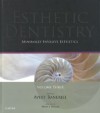 Volume Three
Volume Three
- Avijit Banerjee
This book aims to introduce readers to the concept of minimally invasive dentistry, providing clinical tips and techniques that allow the reader to expand their clinical practice. Applicable to undergraduates, general practitioners and specialists alike, this easy-to-read text enriches the reader's knowledge of the aetiology and minimally invasive approach to managing a range of common conditions that may require aesthetic intervention, such as tooth discolouration, hypoplastic conditions and tooth wear.
With contributions from authors who are internationally renowned for their expertise in the field of minimally invasive aesthetic dentistry, the book is extensively referenced giving clinicians evidence based, ethical management strategies to restore and protect their patient's dentition. The overwhelming ethos of the book is that of tissue and pulpal preservation with a focus on early diagnosis and intervention.
The book is divided into well-structured sections taking the reader on a journey beginning with the diagnosis and treatment options of common clinical conditions that may require aesthetic intervention. It goes on to describe three of the most common minimally invasive management strategies: dental bleaching, adhesive composite restorations and direct/indirect tooth replacement options.
The authors approach subject matter consistently by giving background information, detailing indications and contraindications of each management strategy. Dental materials are discussed and step-by-step protocols guide the reader through the techniques. Packed full of clinical tips and sequential treatment photographs, this book allows any clinician to gain the knowledge and confidence to carry out these techniques.
Each chapter is accompanied by real clinical cases that are illustrated by colour clinical photographs and radiographs. They conclude with suggestions for further reading and often share questions that a patient may frequently ask about the treatment, accompanied by suggested answers. This highlights the importance of patient communication and managing expectations when embarking on aesthetic treatment.
The relaxed, engaging tone, logical structure, rich illustrations and quick reference boxes make this text an invaluable reference source which challenges our attitudes and current approach to managing aesthetic problems, whilst supporting us to make changes to our clinical practice. Both a practical guide and a summary of current literature, I feel this book is a triumph, championing the current shift in the teaching of minimally invasive dentistry and is a must have for any clinician who provides restorative treatment for both children and adults.
Rights and permissions
About this article
Cite this article
Simpson, S. Book review: Essentials of esthetic dentistry: minimally invasive esthetics. Br Dent J 220, 7 (2016). https://doi.org/10.1038/sj.bdj.2016.16
Published:
Issue Date:
DOI: https://doi.org/10.1038/sj.bdj.2016.16

